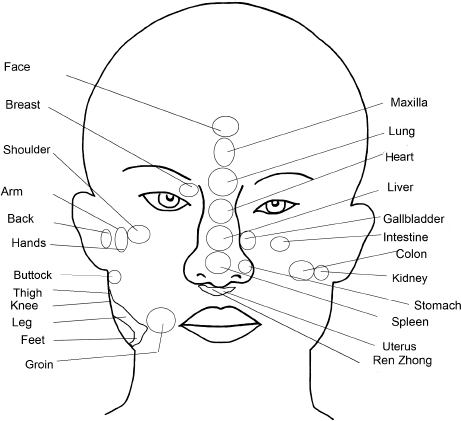The body shape may indicate a condition of excess or deficiency, of a strong or a weak constitution.
A lean, strong body indicates sufficient Qi and Blood. An emaciated body indicates deficiency of Qi and blood, and an overweight body may indicate Dampness and Phlegm.
(1) Observation of body movements
Twitching of muscles, eyelids, mouth, fingers, and toes may be an indication of internal Wind. Inability to lift the head or to maintain a good posture may be a sign of deficient Qi. A patient who prefers to lie down in a bent and covered position may have depleted Yang, while a patient who lies down stretched out in the supine position may have excess Heat.
(2) Observation of the head
The head is where Yang gathers and it is the storage place of the brain and marrow. The quality and quantity of hair may be an indication of the strength of Blood. Normal, often genetically linked balding has very little diagnostic significance.
(3) Observation of the face and complexion
Facial features like local lesions, wrinkles, pigmentation, and patches of changes in color may be valuable as a diagnostic tool. Specific areas on the face correspond to certain Zang-Fu or body parts .
The Inner Canon of the Yellow Emperor mentions a correspondence between the left cheek and the Liver, the right cheek and the Lungs, forehead and Heart, the chin and the Kidneys, and the Nose and the Spleen.
Significance of the complexion:
- A green (Blue–green) color in the complexion may indicate the presence of Wind (lighter green), Cold (darker green), pain, or Wind generated by fright. The appearance of this color in the complexion may also be an expression of Liver pathology. If the green complexion is seen together with Spleen pathology, there is a possibility of the Liver overacting on the Spleen (see the Five Elements Theory).
- A red color in the complexion may indicate the presence of Heat. A very pronounced redness usually indicates the presence of Excess Heat, while a malaria flush is usually seen as a sign of Yin deficiency.
- A yellow color in the complexion may indicate a condition of Dampness and is often linked to dysfunction of the Spleen. The Dampness often combines with Heat, in which case the yellow complexion is more pronounced and deep, like the yellow of a lemon or an orange. A pale-yellow complexion may indicate that the Spleen is deficient. If the yellow complexion is sallow, Damp-Cold may be a factor.
- A white complexion commonly indicates the presence of Cold, and deficiency of Qi, Blood, or body fluids.
- A dark (black) complexion may indicate the presence of Cold, pain, or dampness. The black color is usually associated with serious disease.
- If the color appears to be more superficial, the disease is usually located at the exterior (surface), while a “deep” color may indicate that the disease is more lodged in the interior. A bright appearance of the color can indicate that Yang is affected, while a murky color may indicate a Yin disharmony.
Observation of the body shape
| Strong constitution | Weak constitution |
|---|---|
| Strong bones, wide thorax, firm muscles, good posture | Weak (thin) bones, small thorax, emaciation, poor posture |


